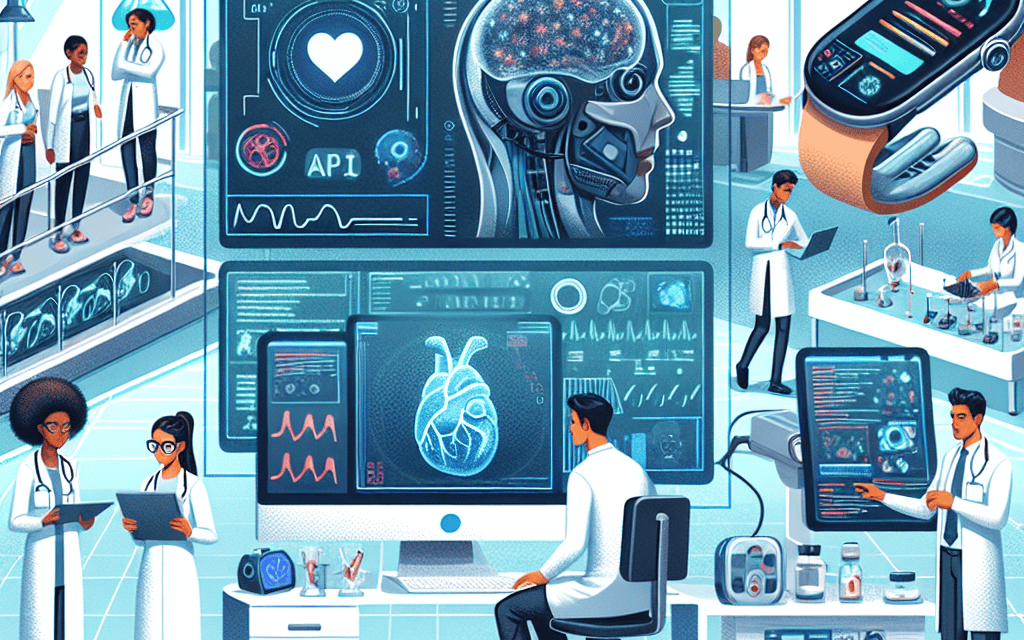Revolutionizing Digital Health: AI Diagnostics and Next-Gen Wearable Technology
The digital health landscape is undergoing a seismic shift, driven by advancements in artificial intelligence (AI) diagnostics and next-generation wearable technology. These innovations are not only enhancing patient care but also transforming the way healthcare providers approach diagnosis, treatment, and patient engagement. This article delves into the various facets of this revolution, exploring the implications of AI diagnostics, the evolution of wearable technology, and the future of digital health.
1. The Rise of AI in Healthcare Diagnostics
Artificial intelligence has emerged as a game-changer in healthcare diagnostics, offering unprecedented accuracy and efficiency. AI algorithms can analyze vast amounts of data, identify patterns, and provide insights that were previously unattainable. This section explores the various applications of AI in diagnostics, its benefits, and the challenges it faces.
1.1 Applications of AI in Diagnostics
AI is being utilized in various diagnostic fields, including radiology, pathology, and genomics. Here are some notable applications:
- Radiology: AI algorithms can analyze medical images, such as X-rays and MRIs, to detect anomalies like tumors or fractures. For instance, Google’s DeepMind developed an AI system that outperformed human radiologists in breast cancer detection.
- Pathology: AI can assist pathologists in analyzing tissue samples, improving the accuracy of cancer diagnoses. A study published in JAMA Oncology found that an AI model could match or exceed the diagnostic performance of pathologists in identifying prostate cancer.
- Genomics: AI is revolutionizing genomics by enabling faster and more accurate interpretation of genetic data. Companies like 23andMe and Illumina are leveraging AI to provide insights into genetic predispositions to diseases.
1.2 Benefits of AI Diagnostics
The integration of AI into diagnostics offers several advantages:
- Increased Accuracy: AI algorithms can analyze data with a level of precision that reduces the likelihood of human error.
- Efficiency: AI can process large datasets quickly, allowing for faster diagnoses and treatment plans.
- Cost-Effectiveness: By streamlining the diagnostic process, AI can reduce healthcare costs associated with misdiagnoses and unnecessary tests.
1.3 Challenges and Ethical Considerations
Despite its potential, the use of AI in diagnostics is not without challenges:
- Data Privacy: The use of patient data raises concerns about privacy and security. Ensuring compliance with regulations like HIPAA is crucial.
- Bias in Algorithms: AI systems can inherit biases present in training data, leading to disparities in healthcare outcomes.
- Regulatory Hurdles: The approval process for AI diagnostic tools can be lengthy and complex, delaying their availability in clinical settings.
2. Next-Generation Wearable Technology
Wearable technology has evolved significantly, moving beyond fitness tracking to encompass a wide range of health monitoring capabilities. This section examines the advancements in wearable technology, their applications in healthcare, and the implications for patient engagement.
2.1 Evolution of Wearable Devices
Wearable technology has come a long way since the introduction of basic fitness trackers. Today, devices are equipped with advanced sensors and connectivity features:
- Smartwatches: Devices like the Apple Watch and Fitbit now offer heart rate monitoring, ECG capabilities, and even blood oxygen level tracking.
- Health Monitors: Wearables like continuous glucose monitors (CGMs) provide real-time data for diabetes management, allowing users to track their glucose levels continuously.
- Smart Clothing: Innovations in smart textiles enable the integration of sensors into clothing, providing insights into posture, movement, and even muscle activity.
2.2 Applications in Healthcare
Wearable technology is being utilized in various healthcare applications:
- Chronic Disease Management: Wearables can help patients manage chronic conditions by providing real-time data to both patients and healthcare providers.
- Remote Patient Monitoring: Wearables enable healthcare providers to monitor patients remotely, reducing the need for in-person visits and improving access to care.
- Preventive Health: By tracking vital signs and activity levels, wearables can help identify potential health issues before they become serious.
2.3 Enhancing Patient Engagement
Wearable technology plays a crucial role in enhancing patient engagement:
- Real-Time Feedback: Wearables provide users with immediate feedback on their health metrics, encouraging them to make healthier choices.
- Data Sharing: Patients can share their health data with providers, fostering collaboration in care management.
- Gamification: Many wearables incorporate gamification elements, motivating users to achieve health goals through challenges and rewards.
3. The Intersection of AI and Wearable Technology
The convergence of AI and wearable technology is creating new opportunities for personalized healthcare. This section explores how AI enhances the capabilities of wearables and the implications for patient care.
3.1 AI-Driven Insights from Wearable Data
Wearable devices generate vast amounts of data, and AI can analyze this data to provide actionable insights:
- Predictive Analytics: AI algorithms can analyze historical data to predict potential health issues, allowing for early intervention.
- Personalized Recommendations: AI can tailor health recommendations based on individual data, such as activity levels and heart rate patterns.
- Behavioral Insights: By analyzing user behavior, AI can identify trends and suggest lifestyle changes to improve health outcomes.
3.2 Case Studies of AI and Wearables Integration
Several companies are successfully integrating AI with wearable technology:
- Apple Health: Apple’s Health app uses AI to analyze data from various sources, providing users with a comprehensive view of their health.
- Fitbit Health Solutions: Fitbit’s platform leverages AI to offer personalized health insights and recommendations to users and healthcare providers.
- Oura Ring: The Oura Ring uses AI to analyze sleep patterns and provide insights into sleep quality and recovery.
3.3 Challenges in Integration
While the integration of AI and wearables holds great promise, it also presents challenges:
- Data Overload: The sheer volume of data generated by wearables can overwhelm users and healthcare providers, making it difficult to extract meaningful insights.
- Interoperability: Ensuring that different devices and platforms can communicate effectively is crucial for seamless data sharing.
- User Acceptance: For AI-driven wearables to be effective, users must trust the technology and be willing to engage with it regularly.
4. Regulatory Landscape and Ethical Considerations
The rapid advancement of AI diagnostics and wearable technology raises important regulatory and ethical questions. This section examines the current regulatory landscape and the ethical considerations that must be addressed.
4.1 Current Regulatory Framework
The regulation of AI and wearable technology varies by region, but several key organizations are involved:
- FDA (U.S.): The FDA regulates medical devices, including wearables that provide diagnostic information. They have established guidelines for the approval of AI-based diagnostic tools.
- EMA (Europe): The European Medicines Agency oversees the regulation of medical devices in Europe, including those that utilize AI.
- WHO (Global): The World Health Organization provides guidance on the ethical use of AI in healthcare, emphasizing the need for equitable access to technology.
4.2 Ethical Considerations
As AI and wearable technology become more prevalent, ethical considerations must be addressed:
- Informed Consent: Patients must be fully informed about how their data will be used and the implications of AI-driven diagnostics.
- Bias and Fairness: Developers must ensure that AI algorithms are trained on diverse datasets to avoid perpetuating biases in healthcare.
- Data Ownership: Questions surrounding who owns the data generated by wearables and how it can be used must be clarified.
4.3 Future Regulatory Trends
The regulatory landscape is likely to evolve as technology advances:
- Adaptive Regulation: Regulators may adopt more flexible approaches to accommodate the rapid pace of innovation in AI and wearables.
- Collaboration with Industry: Increased collaboration between regulators and industry stakeholders can lead to more effective regulatory frameworks.
- Global Standards: The establishment of global standards for AI in healthcare could facilitate international collaboration and innovation.
5. The Future of Digital Health
The future of digital health is bright, with AI diagnostics and wearable technology poised to play a central role. This section explores emerging trends and the potential impact on healthcare delivery.
5.1 Emerging Trends in Digital Health
Several trends are shaping the future of digital health:
- Telehealth Integration: The integration of AI and wearables into telehealth platforms will enhance remote care capabilities.
- Personalized Medicine: Advances in AI and genomics will enable more personalized treatment plans based on individual patient data.
- Health Equity: Efforts to address disparities in access to digital health technologies will be crucial for achieving health equity.
5.2 The Role of Data Analytics
Data analytics will play a pivotal role in the future of digital health:
- Predictive Modeling: AI-driven predictive models will help identify at-risk populations and inform preventive strategies.
- Population Health Management: Analyzing data from wearables can provide insights into population health trends, guiding public health initiatives.
- Real-World Evidence: The use of real-world data from wearables will enhance clinical research and inform regulatory decisions.
5.3 Conclusion: A New Era in Healthcare
The integration of AI diagnostics and next-generation wearable technology is ushering in a new era in healthcare. As these technologies continue to evolve, they hold the potential to improve patient outcomes, enhance healthcare delivery, and empower individuals to take charge of their health. However, addressing the challenges and ethical considerations associated with these advancements will be crucial for realizing their full potential.
Conclusion
The revolution in digital health, driven by AI diagnostics and wearable technology, is transforming the healthcare landscape. From enhancing diagnostic accuracy to empowering patients through real-time health monitoring, these innovations are reshaping how we approach health and wellness. As we move forward, it is essential to navigate the regulatory and ethical challenges that accompany these advancements to ensure that the benefits of digital health are accessible to all. The future of healthcare is not just about technology; it is about creating a more equitable, efficient, and patient-centered system that leverages the power of AI and wearables to improve lives.





